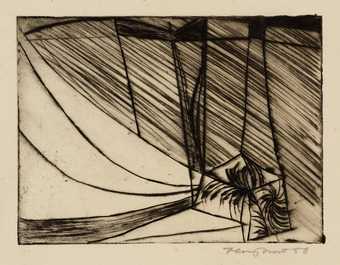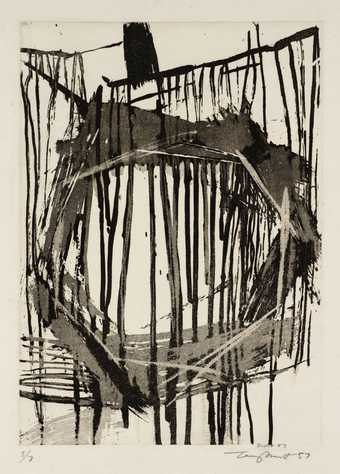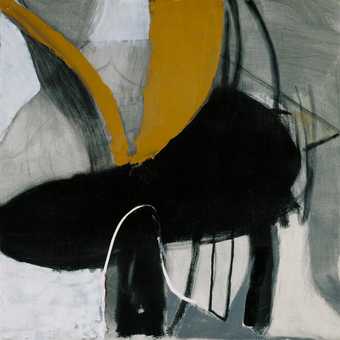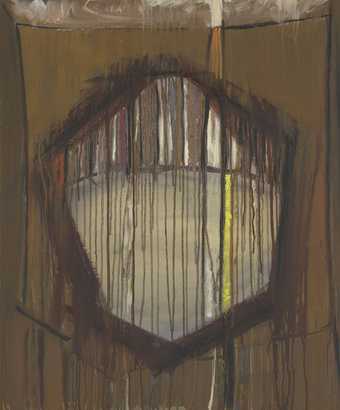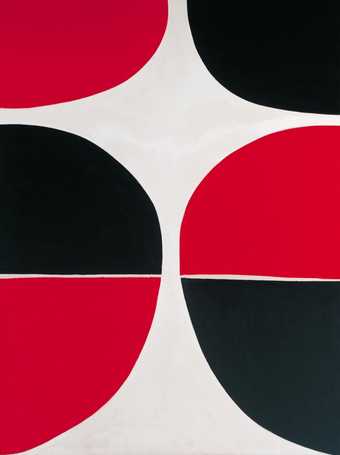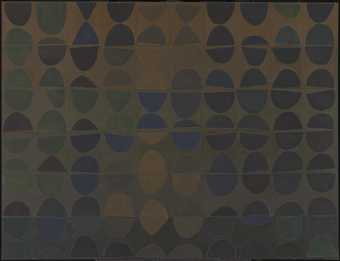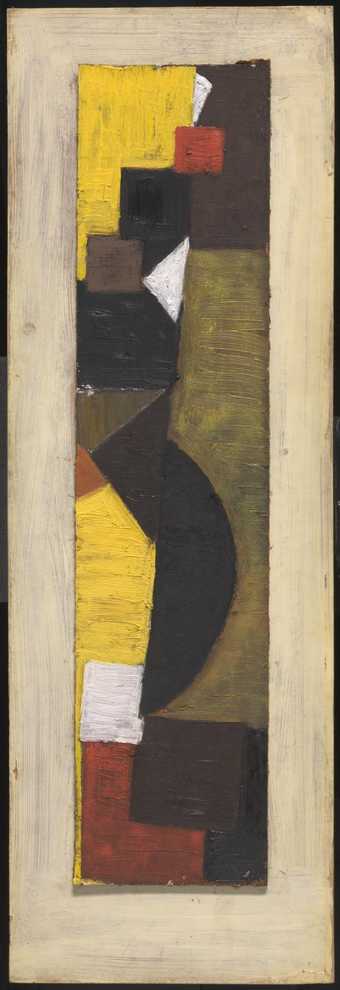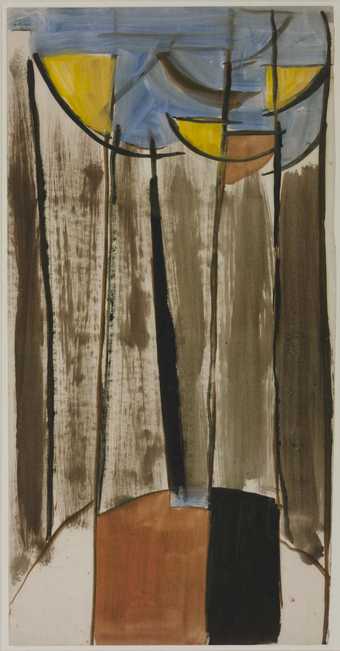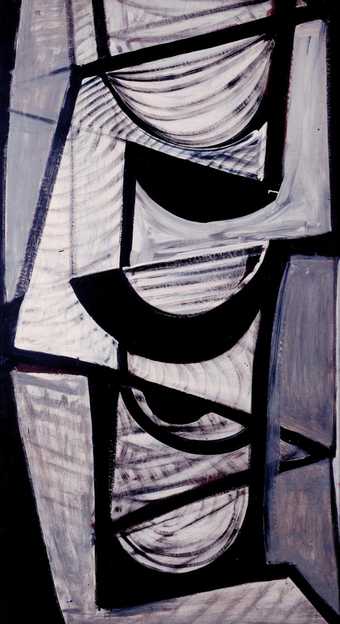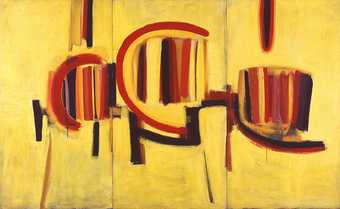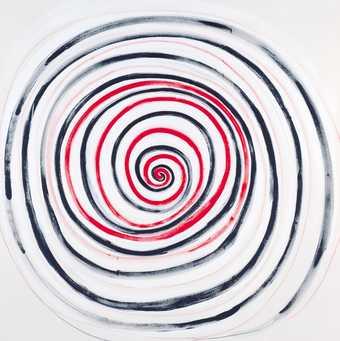
In Tate St Ives
- Artist
- Sir Terry Frost 1915–2003
- Medium
- Oil paint on board
- Dimensions
- Support: 2442 × 1225 mm
frame: 2467 × 1248 × 55 mm - Collection
- Tate
- Acquisition
- Purchased 1974
- Reference
- T01924
Display caption
Gallery label, September 2004
Does this text contain inaccurate information or language that you feel we should improve or change? We would like to hear from you.
Catalogue entry
Terry Frost born 1915
Winter 1956, Yorkshire
1956
T01924
Oil on hardboard 2467 x 1251 (97 1/8 x 49 ¼)
Inscribed on back in black oil paint ‘↑ TOP ↑ | Terry Frost | Winter 1956 | Yorkshire’ top
Purchased from the Waddington Galleries (Grant-in-Aid) 1974
Exhibited:
Pictures Submitted for the Guggenheim Painting Awards, Manchester City Art Gallery, June 1958 (33, as Winter 1956)
Guggenheim International Award 1958, Solomon R. Guggenheim Museum, New York 1958-9 (no number, as Winter 1956)
St Ives 1939-64: Twenty Five Years of Painting, Sculpture and Pottery, Tate Gallery, London, February-April 1985 (166, reproduced p.201)
St Ives, Hyogo Prefectural Museum of Modern Art, April-May 1989, Museum of Modern Art, Kamatura, May-June, Setagaya Art Museum, July-August (75, reproduced in colour p.90)
Literature:
Terry Measham, The Moderns, Oxford 1976, no.25, reproduced in colour
Terry Frost: Paintings, Drawings and Collages, exhibition catalogue, Arts Council/South West Arts tour 1976/77, Plymouth City Museum & Art Gallery, November-December 1976, Royal West of England Academy, Bristol, December 1976-January 1977, Serpentine Gallery, London, February-March, Laing Art Gallery, Newcastle upon Tyne, April-May, Leeds City Art Gallery, May-June, Birmingham City Museum and Art Gallery, July 1977, p.14
Tate Gallery Acquisitions 1974-6, London 1978, pp.95-6, reproduced
Adrian Heath, ‘Recollections and Movements’ in David Lewis, Terry Frost, Aldershot 1994, p.16, reproduced p.51 (colour)
Margaret Garlake, New Art New World: British Art in Postwar Society, New Haven and London 1998, p.166, reproduced p.167
Chris Stephens, Terry Frost, London 2000, p.39, 43, reproduced p.40 (colour)
‘I do believe in moments of truth. Moments when everything seems clear and one is transported out of the normal. Somehow one is more aware, able to see.’[1] Terry Frost has habitually explained his paintings from the 1950s in terms of personal narrative and this is the case with Winter 1956, Yorkshire. An earlier Tate Gallery catalogue entry, based upon a conversation with the artist,[2] recounted the occasion which, he said, had inspired it. He repeated a similar story in some abbreviated notes:
Frost summarised the subject for David Brown: ‘The Tate picture expressed what happened to me when I went from top to bottom of the hill’.[4] He added that, after the tobogganing experience, he ‘went home and laid in the main composition of this picture the same night, painting the black lines with a 6 in. paint brush used end on, which would hold enough paint to go from top to bottom of the panel’.[5] His working method was not completely ‘free’, he explained subsequently, for a work such as this he would have made a few preliminary doodles.[6] Such drawings, examples of which have been reproduced,[7] often reveal more clearly the translation of the external source to the final painting.
The use of an abstract idiom to express a perceived or experienced sense of movement was an established aspect of Frost’s work. Walk Along the Quay, 1950 (private collection on loan to Graves Art Gallery, Sheffield)[8] was said to be based on the sensation of walking along St Ives quay and he had produced a group of paintings and collages which drew on the movement of boats in the harbour, such as Green, Black and White Movement, 1951 (Tate Gallery T01501). However, the drawing of a parallel between his remembered movement in space and the movement of the brush over the board was a new departure.
Winter 1956, Yorkshire is not purely black and white. The black verticals are interspersed with ochre and pale blue lines, while the concave curve, which the artist associated with a dip in the landscape, encloses a brown area, part of which has been thinly overpainted with white. It was painted at the beginning of 1956 and was certainly finished by 8 March, as the completed painting is visible in the background of photographs of Frost’s Leeds studio taken by Roger Mayne on that day.[9] Frost had lived in Leeds since October 1954, when he had been appointed the Gregory Fellow in painting at the university. Armitage was the sculpture Fellow and the poetry Fellow was Tom Blackburn, whose wife Rosalie participated in the tobogganing mission. The painter and sculptor each had a flat in a house provided by the university at 38 Moor Road, Headingly and it was there that Winter 1956 was painted. Frost’s tenure as Gregory Fellow lasted for two years but when he was succeeded by Alan Davie in 1956,, he remained in the city and taught at Leeds College of Art until 1957. The Gregory Fellowship scheme was established by the publisher E.C. Gregory to introduce practising artists into the university where they had few obligations beyond pursuing their own work, for which they received a small stipend. Around the same time, Harry Thubron was appointed to Leeds College of Art where he introduced the Bauhaus-inspired regime of Basic Design. This was a course in the theory of artistic form and composition which all students at the college had to take and which became a model for art education elsewhere. Thubron encouraged the involvement of visiting lecturers and Frost and the other Gregory Fellows all contributed to the programme. The coincidence of the Gregory scheme with the revitalisation of the art college, combined with an established network of local collectors, ensured Leeds’ status as an important centre for avant-garde art practice in Britain in the late 1950s. The critic Herbert Read, who also lived in Yorkshire, stood as an eminence grise over that scene.
Winter 1956 was one of a group of predominantly black and white paintings from this period all of which were said to have derived from the rolling landscape of Yorkshire with its snowy hills articulated by the black stone walls of the fields. The artist recalled the effect of the different experience of this landscape, which seemed to tower over him, in contrast to standing on top of the coastal moors of Cornwall: ‘in Cornwall you’re a giant; in Yorkshire ‘a pin-prick’.[10] In Leeds Frost also produced works in a fiery orange, yellow or red and these were associated with the experience of the same landscape in the heat of summer.[11] Frost has also associated his use of black and white vertical forms to the view from his flat of the Dales seen through blackened chimneys of north Leeds.[12]
Though Frost later recalled of the Leeds years that, ‘Black & White were my passion at that time,’[13] and associated this painting with a particular situation, the use of a palette largely restricted to black and white was not new. It had been seen, for example, in a number of the ‘movement’ series, most notably the large Black and White Movement, 1952 (Tate Gallery T06607). Such monochromatic compositions recalled Picasso’s wartime work which was shown in London in December 1945 in the Victoria and Albert Museum’s Picasso and Matisse exhibition. The restricted palette had appeared in the work of Roger Hilton and William Scott between 1952 and 1954; both artists produced painterly works consisting of a few straight black lines through white which, in their simplified colour and form, focused attention on the painting’s structure. Several of Scott’s works, such as Harbour, 1952 (private collection) and Figure into Landscape, 1953 (private collection),[14] are anchored by a black square in a manner that anticipates Winter 1956.
The stark contrast of black and white could have been reinforced by Frost’s first viewing of the work of the American Franz Kline, which was shown in Britain for the first time in the exhibition Modern American Painting at the Tate Gallery in January 1956. Kline’s large-scale, gestural calligraphy might be seen as closer to Frost’s rapid working than the carefully worked textures of Scott and Hilton. In fact, Frost may have known Kline’s black and white paintings from an article which appeared in 1952 alongside Harold Rosenberg’s essay on the ‘American Action Painters’ which was known in Britain.[15] The Tate exhibition also included work by Jackson Pollock, Mark Rothko, Clyfford Still and Willem de Kooning. Though Pollock’s work had been seen in Britain and the others’ had been reported, the exhibition reasserted the grand scale of the new American painting. However, Frost had been producing large works for some time: Coastal Figure, St Ives 1952-3, which was made for the Contemporary Art Society’s 1953 Figures in their Setting exhibition at the Tate Gallery, is ten feet (3048mm) high. Frost reported that he had a half-brother in the timber business who was able to supply considerable quantities of larger than usual sheets of hardboard.[16] With canvas scarce, expensive and less robust, hardboard was used by many artists in the 1950s.
Frost painted on the rough face of the 3mm hardboard before it had been strengthened and the photograph of his studio shows the finished work bending as it leans against the wall.[17] The painting was at one time strengthened with five horizontal wooden battens, to which the simple frame was screwed. Two were ‘edge-on’ to the back of the board and appeared to be original and the other three were flat and were probably added later. The two originals prevented a general bending of the board. It was concave towards the top and the bottom. In 1989 the battens were removed, the board was strengthened with a 5mm ‘Artcor’ sheet and a new eleven-member timber frame was attached. The frame remains and appears to be original, though holes in the edges of the board, especially in the top right hand corner, suggest it may have been attached to a different frame at some point. It is painted pale grey, with the face adjacent to the painting being white. The board was not sized and so remained absorbent; as a result, the ground, which is unevenly distributed, is very lean. The leanness and the movement of the support has caused crackling with a horizontal emphasis. The ground and paint layers are thin enough for the texture of the board to be visible in places. The ochre, blue and, especially, the yellow are soluble in water.[18]
Chris Stephens
December 2000
[2] Conversation with David Brown, 8 December 1974
[5] Ibid.
[6] Interview with the author, 4 May 1998
[7] Reproduced in David Lewis, Terry Frost, Aldershot 1994, p.65; Mel Gooding, Terry Frost: Act and Image, Works on Paper Through Six Decades, London 2000, unpaginated, pls.35-9
[11] Ibid., p.73
[12] Letter to Claude Rogers, not dated [1960s], Tate Gallery Archive
[14] Reproduced in Michael Tooby and Simon Morley, William Scott: Paintings and Drawings, exhibition catalogue, Irish Museum of Modern Art, Dublin 1964, nos 20 and 21
Explore
- abstraction(8,615)
-
- from recognisable sources(3,634)
-
- landscape(1,191)
- emotions and human qualities(5,345)
-
- exhilaration(50)
- recreational activities(2,836)
-
- tobogganing(1)
- Leeds(145)
- England(19,202)
You might like
-
Sir Terry Frost Boat Shapes
1954 -
Sir Terry Frost Leeds
1956 -
Sir Terry Frost Composition
1957 -
Roger Hilton January 1957
1957 -
Sir Terry Frost Khaki and Lemon
1956 -
Sir Terry Frost June, Red and Black
1965 -
Sir Terry Frost Green, Black and White Movement
1951 -
Sir Terry Frost Through Blacks
1969 -
Sir Terry Frost Brown and Yellow
c.1951–2 -
Sir Terry Frost Untitled Composition
c.1955 -
Sir Terry Frost May 1962 (Stays)
1962 -
Sir Terry Frost Black and White Movement
1952 -
Sir Terry Frost Yellow Triptych
1957–9 -
Sir Terry Frost R. B. and W. Spiral for A.
1991 -
Sir Terry Frost Leeds Landscape
c.1956


